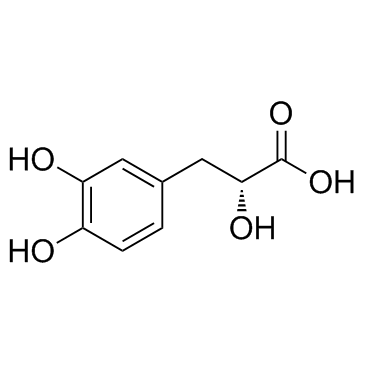76822-21-4
| Name | (2R)-3-(3,4-dihydroxyphenyl)-2-hydroxypropanoic acid |
|---|---|
| Synonyms |
Danshensu
Sodium (2R)-3-(3,4-dihydroxyphenyl)-2-hydroxypropanoate (2R)-3-(3,4-Dihydroxyphenyl)-2-hydroxypropanoic acid Benzenepropanoic acid, α,3,4-trihydroxy-, sodium salt, (αR)- (1:1) Salvianic |
| Description | Danshensu, an active ingredient of Salvia miltiorrhiza, shows wide cardiovascular benefit by activating Nrf2 signaling pathway. |
|---|---|
| Related Catalog | |
| In Vitro | Danshensu (DSS) significantly decreases the level of the marker enzymes (creatine kinase and lactate dehydrogenase) from the coronary effluents and myocardial infarction size. This could markedly contribute to the recovery of cardiac function after I/R injury. DSS also has ROS scavenging activity and boosts endogenous antioxidants such as SOD, CAT, MDA, GSH-PX and HO-1 activities by activating nuclear factor erythroid-2-related factor 2 (Nrf2) signaling pathway which is mediated by Akt and ERK1/2 in western blot analysis[2]. |
| In Vivo | Acute treatment with a single dose of danshensu in rats with normal tHcy does not change plasma tHcy. In contrast, danshensu significantly lowers tHcy in rats with elevated tHcy. The relatively higher cysteine and glutathione levels after treatment with danshensu indicates that its tHcy-lowering effect is via increased activity of the trans-sulphuration pathway[1]. |
| Animal Admin | All chemicals are dissolved in saline, except for tolcapone which is dissolved in saline containing 20% (v/v) PEG 200. During experiments, rats are fasted overnight and randomLy assigned into different groups. About 200 µL blood is taken from orbital sinus alternatively after ethyl ether anaesthesia, and then the eye is quickly sterilized with alcohol and pressed with cotton. Blood samples are immediately collected into a polypropylene tube containing heparin-Na and centrifuged at 5000 g at 5°C for 3 min. Prepared plasma samples are kept at −20°C and analysed within 48 h. |
| References |
| Density | 1.5±0.1 g/cm3 |
|---|---|
| Boiling Point | 481.5±40.0 °C at 760 mmHg |
| Molecular Formula | C9H10O5 |
| Molecular Weight | 198.17 |
| Flash Point | 259.1±23.8 °C |
| PSA | 97.99000 |
| LogP | -0.29 |
| Vapour Pressure | 0.0±1.3 mmHg at 25°C |
| Index of Refraction | 1.659 |
| Hazard Codes | Xi |
|---|---|
| HS Code | 2942000000 |
| HS Code | 2942000000 |
|---|
